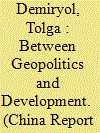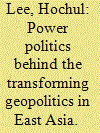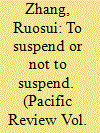|
|
|
Sort Order |
|
|
|
Items / Page
|
|
|
|
|
|
|
| Srl | Item |
| 1 |
ID:
187370


|
|
|
|
|
| Summary/Abstract |
What drives China’s Belt and Road Initiative (BRI)? While some claim that the BRI is primarily about economic development, others see it as a grand strategy of a rising power with hegemonic aspirations. Is the BRI about development or geopolitics? This article adopts a political economy approach to bridge the developmental and geopolitical perspectives on the BRI. The primary argument is that the BRI signifies an attempt by the Chinese state to manage internal problems of capital accumulation by externalising development. In this sense, this is a typical crisis of capitalist development which generates a drive for geographic expansion and restructuring. The distinguishing feature of the BRI, apart from its sheer scale, is its emphasis on connectivity. Rather than simply exporting excess capital and capacity onto others, the BRI seeks to re-territorialise developmental spaces by connecting them via economic corridors consisting of hard and soft infrastructure networks. It is also contended here that in the process of constructing new infrastructures of capital, the BRI creates space for new forms of asymmetric interdependence between China and its partners. To the extent that such asymmetric relations generate costs of exiting China-centred networks, the initiative serves a geopolitical as well as a developmental function. Asymmetric interdependencies, whether they are by design or by-products of enhanced connectivity, thus facilitate China’s pursuit for a more prominent role in the international order.
|
|
|
|
|
|
|
|
|
|
|
|
|
|
|
|
| 2 |
ID:
182691


|
|
|
|
|
| Summary/Abstract |
In terms of spatial imaginaries and as physical infrastructure, the Belt and Road Initiative (BRI) spurs new geographies of comparative urban study. Irrespective of whether it is the primary driver for developments carried out in its name, ‘the BRI’ is a label that serves to bring previously unassociated project sites and non-place-based infrastructural developments into comparative relation. This paper considers some of the possibilities presented by the BRI for comparative urban studies in – and from – Asia. Building upon insights from postcolonial urban studies, planetary urbanisation and inter-Asia cultural studies, I sketch two key possibilities of the BRI as (comparative urban) method. The first concerns the BRI as a series of openings to much (spatially) wider and historically deeper forms of comparison. Second, I argue that BRI as method impels forms of urban comparison beyond conventionally territorialised units of analysis at a variety of scales, including both the city and the (area studies) region.
|
|
|
|
|
|
|
|
|
|
|
|
|
|
|
|
| 3 |
ID:
166552


|
|
|
|
|
| Summary/Abstract |
Because nearly five years have passed since China's Belt and Road Initiative (BRI) was implemented, there is an urgent need to explore whether it has significantly promoted provincial green economy development. Focusing on the primary provinces along its route, this study uses a GML index based on SBM directional distance function to evaluate provincial green total factor productivity (GTFP) and quantitatively analyses the BRI's net effect on provincial GTFP. The results indicate that provincial GTFP development is relatively good, with technological progress being its main driving force, there are significant differences between the regional GTFP development along the Silk Road Economic Belt (SREB) and the Maritime Silk Road (MSR), and the BRI has played a significant role in promoting provincial and two regional GTFP. R&D investment inhibits provincial GTFP development while it is not significant. There is a U-shaped relationship between economic development and GTFP, a negative correlation between the current provincial economic level and GTFP. Trade between provinces and countries along the route has a negative effect on GTFP. To promote GTFP development, the provinces should value foreign trade, improve innovation mechanism, cultivate talents and actively embed in the BRI construction.
|
|
|
|
|
|
|
|
|
|
|
|
|
|
|
|
| 4 |
ID:
192547


|
|
|
|
|
| Summary/Abstract |
The rise of China and the introduction of the Belt and Road Initiative have intensified regional great power competition. Seemingly, China and Japan have been competing over the export of infrastructure projects and access to the Southeast Asian market. Against this backdrop, this paper sheds light on recipient states’ agency. Specifically, this paper explores how Indonesia has responded to Sino-Japanese competition through the perspective of economic hedging. In the realm of domestic railway development and the need to establish connectivity on Java, why did the Indonesian government decide to work with China to develop the Jakarta-Bandung High-speed Rail project and Japan on the North Java Upgrading Line, as the two lines are not interoperable? Railway policy in Indonesia is strategic and pragmatic. On the one hand, Sino-Japanese competition diversifies Indonesia’s options as it continues striving to strengthen infrastructure development. On the other hand, the need continually to strike a balance between the two great powers requires skill and flexibility. Therefore, maintaining policy autonomy and accepting economic costs make-up secondary states’ responses to great power competition in turbulent times.
|
|
|
|
|
|
|
|
|
|
|
|
|
|
|
|
| 5 |
ID:
158059


|
|
|
|
|
| Summary/Abstract |
Current geopolitical dynamics in East Asia is generated by the US rebalancing and China’s counterbalancing. The US rebalancing has so far ended in an encircling of China, whereas China counteracts to extend into the seas and the lands as typified by the Belt and Road Initiative and assertive activities in the South China Sea. China under Xi Jinping’s leadership has set up a new guideline of ‘great power foreign policy’ (大国外交) to realize Xi Jinping’s ambitious vision of ‘China dream’. As delivered in the ‘New Model of Great Power Relations’, China under Xi Jinping’s leadership seeks clearly for ‘regional dominance’, while for ‘global balance’ with the USA. With rebalancing, however, the USA seeks to restore power balance in East Asia by adding up to military and economic resources already deployed there. By doing so, the USA aims to achieve its strategic goal of ‘regional balance’, while maintaining ‘global dominance’. These two distinct strategic goals, regional dominance and global balance for China and regional balance and global dominance for the USA, interact to result in currently transforming geopolitics in East Asia.
|
|
|
|
|
|
|
|
|
|
|
|
|
|
|
|
| 6 |
ID:
185554


|
|
|
|
|
| Summary/Abstract |
This article investigates three Chinese multibillion overseas investment projects in Myanmar—the Myitsone dam, the Letpadaung copper mine, and the Sino-Myanmar oil and gas pipelines—over the course of three consecutive Myanmar governments. It explains why these mega-projects obtained varying degrees of success in terms of their completion and operation status and why only the dam project was unilaterally suspended following Myanmar’s controlled and peaceful power transition in 2011. Through a structured and focused comparison, this article argues that the “people’s will” is not the reason why President Thein Sein halted the Myitsone dam project, despite his claims and contrary to much scholarly research on this case. Rather, the cost-benefit calculations of Myanmar government, in particular how it weighed the urgency of national security against other costs and benefits such as appeasing or failing the domestic opposition, determine the varying degrees of success both over time and across projects. This article draws implications for the completion and operation status of Chinese overseas investment projects around the globe.
|
|
|
|
|
|
|
|
|
|
|
|
|
|
|
|
|
|
|
|
|